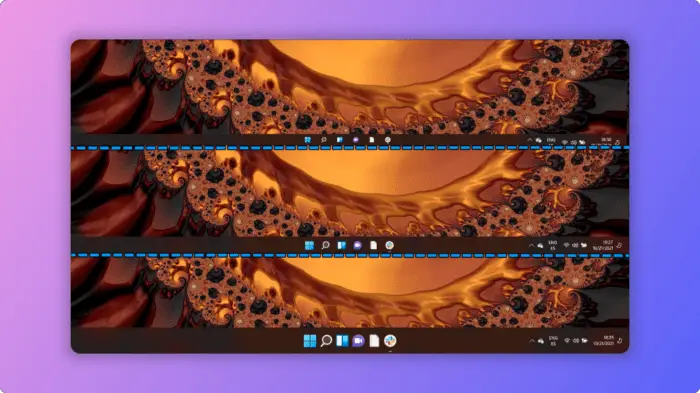- Use the registry editor to set the taskbar size to small, medium, or large
- Download third-party apps like ExplorerPatcher to customize taskbar settings
- Change the taskbar size using the registry or third-party apps
The taskbar is an essential part of the Windows experience, providing quick access to frequently used applications and system utilities. In Windows 11, Microsoft has made some changes to the taskbar’s appearance and functionality, including a larger default size. While some users may appreciate the more prominent taskbar, others might find it too large or prefer a more compact layout. Fortunately, there are ways to resize the taskbar in Windows 11 to suit your preferences.
Table of Contents
- Resizing the Taskbar Using the Registry Editor
- Using Third-Party Apps to Resize the Taskbar
- Changing the Taskbar Size Using the Settings App
- FAQ
- How do I resize the taskbar in Windows 11?
- Can I make the taskbar smaller in Windows 11?
- Why can’t I resize the taskbar in Windows 11?
- Is it safe to modify the registry to resize the taskbar?
- Are there any third-party apps that can resize the taskbar in Windows 11?
- Can I restore the default taskbar size in Windows 11?
- Additional Customization Options for Your Taskbar
Resizing the Taskbar Using the Registry Editor
One method to resize the taskbar in Windows 11 is by modifying the registry. The registry is a hierarchical database that stores low-level settings and options for the operating system and its components. While this approach is effective, it’s important to exercise caution when making changes to the registry, as incorrect modifications can potentially cause system instability or other issues.
To resize the taskbar using the registry editor, follow these steps:
- Press the Windows key + R to open the “Run” dialog box.
- Type
regeditand press Enter to launch the Registry Editor. - Navigate to the following key:
HKEY_CURRENT_USER\Software\Microsoft\Windows\CurrentVersion\Explorer\Advanced - Right-click in the right pane and select “New” > “DWORD (32-bit) Value”.
- Name the new value “TaskbarSi”.
- Double-click on the “TaskbarSi” value and set the following values:
- Value data 0: Small taskbar
- Value data 1: Medium taskbar (default)
- Value data 2: Large taskbar
After making the desired change, you’ll need to restart the Explorer process for the changes to take effect. You can do this by opening Task Manager, navigating to the “Processes” tab, selecting “Windows Explorer” from the list, and clicking “Restart”.
Note: Modifying the registry can be risky if not done correctly, so it’s recommended to create a backup of the registry before making any changes.
Using Third-Party Apps to Resize the Taskbar
If you prefer not to modify the registry directly, you can use third-party applications to resize the taskbar in Windows 11. These applications provide a user-friendly interface for adjusting various system settings, including the taskbar size.
One popular third-party app for customizing the Windows 11 taskbar is ExplorerPatcher. Here’s how to use it to resize the taskbar:
- Download and install ExplorerPatcher from the official GitHub repository.
- Launch ExplorerPatcher.
- In the main window, click on the “Taskbar” tab.
- Under “Taskbar Size,” select the desired size from the dropdown menu (Small, Medium, or Large).
- Click on the “Apply” button to save the changes.
ExplorerPatcher also provides various other options for customizing the taskbar, such as changing the taskbar position, hiding specific taskbar elements, and more.
Another popular third-party app for taskbar customization is StartAllBack. This app offers a wide range of customization options, including taskbar size adjustment. Here’s how to use it:
- Download and install StartAllBack from the official website.
- Launch StartAllBack.
- Navigate to the “Taskbar” tab.
- Adjust the “Taskbar Size” slider to your desired size.
- Click on the “Apply” button to save the changes.
StartAllBack also includes additional features like customizing the Start menu, enabling classic Windows 10 context menus, and more.
Changing the Taskbar Size Using the Settings App
While the Windows 11 Settings app doesn’t provide a direct option to resize the taskbar, you can adjust the overall scaling of the user interface, which will affect the taskbar’s size as well. Here’s how:
- Open the Settings app by pressing the Windows key + I.
- Navigate to “System” > “Display”.
- Under the “Scale & Layout” section, adjust the “Scale” setting to your desired value.
- Click “Apply” to save the changes.
Keep in mind that changing the scaling will affect the entire user interface, not just the taskbar. Additionally, this method may not provide as precise control over the taskbar size as the registry or third-party app methods.
FAQ
How do I resize the taskbar in Windows 11?
There are three main methods to resize the taskbar in Windows 11:
- Registry Editor: Navigate to
HKEY_CURRENT_USER\Software\Microsoft\Windows\CurrentVersion\Explorer\Advanced, create a new DWORD (32-bit) Value named “TaskbarSi”, and set the value data to 0 (small), 1 (medium), or 2 (large). - Third-party apps: Use apps like ExplorerPatcher or StartAllBack to access taskbar size settings.
- Display Settings: Adjust the overall scaling of the user interface, which will also affect the taskbar size.
Can I make the taskbar smaller in Windows 11?
Yes, you can make the taskbar smaller in Windows 11 by using the registry editor or third-party apps like ExplorerPatcher. These tools allow you to change the taskbar size to a smaller value.
Why can’t I resize the taskbar in Windows 11?
Windows 11 doesn’t provide a built-in option to resize the taskbar directly. However, you can use the methods mentioned above to change the taskbar size by modifying the registry or using third-party apps.
Is it safe to modify the registry to resize the taskbar?
Modifying the registry can be risky if not done correctly, as it can potentially cause system instability or other issues. It’s recommended to create a backup of the registry before making any changes, and to exercise caution when editing registry entries.
Are there any third-party apps that can resize the taskbar in Windows 11?
Yes, there are several third-party apps that can resize the taskbar in Windows 11, such as ExplorerPatcher and StartAllBack. These apps provide a user-friendly interface for adjusting the taskbar size and other settings.
Can I restore the default taskbar size in Windows 11?
Yes, you can restore the default taskbar size in Windows 11 by undoing the changes made through the registry editor, third-party apps, or display settings. Alternatively, you can create a new user account, which will reset the taskbar to its default size.
Additional Customization Options for Your Taskbar
Want more control over your taskbar?
Beyond resizing, there are other ways to make your taskbar fit your style and needs. Here are some ideas:
Adjust Taskbar Transparency
You can make your taskbar transparent to give it a sleek, modern look. Use tools like TranslucentTB to achieve this effect. This lightweight app allows you to adjust the opacity and color of your taskbar, creating a cleaner desktop aesthetic. Download it from the Microsoft Store or GitHub.
Explore Icon Customization
If resizing isn’t enough, consider customizing your taskbar icons. Apps like TaskbarX let you center icons, add animations, or even tweak spacing for a more personalized layout. You can find TaskbarX on GitHub or other trusted platforms.
Combine Taskbar Tweaks for Maximum Impact
For those who want an all-in-one solution, Windhawk offers a modular approach to taskbar customization. With its “Taskbar Height and Icon Size” mod, you can tweak dimensions without affecting other UI elements like text clarity—perfect for those who want precision adjustments.
Ready to take your setup further? Experiment with these tools and create a desktop experience tailored just for you!

